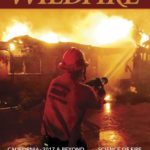Charcoal from forest fires accumulates in the bottom of nearby lakes and becomes part of the sediment sequence (muck that slowly accumulates each year at the bottom of the lake). By examining the charcoal found in the sediment sequence we can retrace forest fire histories for as long as the lake has been around; in Northern Ontario, that can be up to 8000 years!
There is a surprising amount of information stored in charcoal which can be gained by studying the morphology (shape). For example, the temperature of a fire will determine the size, density, structure, and shape of the charcoal produced (2). The type of vegetation burned will also impact the formation of charcoal and since the structure of the plant matter burned can remain intact, species burned can sometimes be identified and information on the environment can be reconstructed (1). Another important aspect impacting charcoal morphology is transportation. Heavy rainfall or river flow can erode and modify charcoal as it is carried into the sediment sequence.
In 2006, Enache and Cumming published a paper describing charcoal morphotypes (categories based on shape) in Prosser Lake, British Columbia, Canada (1). In order to asses how useful the morphotypes were in reconstructing past fires, they compared the charcoal found in the sediment sequence of Prosser Lake from the last ~100 years to the known fire history of the area.
First, the morphotypes. Seven morphotypes were found and described from Prosser Lake sediment: Type M, P, C, S, B, D, and F.
Type M charcoal has an irregular shape and porosity (tiny holes in the charcoal). Type M charcoal is also very thin and can be easily broken when touched.



Caption: Examples of Type M charcoal from Enache and Cumming (2006) Figure 3 (i-k)
Type P charcoal consists of black powdery amorphous (no shape) sheets. It can be identified based on colour, opacity (non-transparent), and powdery character.

Caption: Example of Type P charcoal from Enache and Cumming (2006) Figure 3 (n)
Type C charcoal is the most common type of charcoal found in the sedimentary sequence. It is compact and has an angular-irregular shape (straight edges and sharp corners but irregularly connected). Type C charcoal has no visible porosity but woody cell structures can sometimes be seen if the charcoal is broken open.


Caption: Examples of Type C charcoal from Enache and Cumming (2006) Figure 3 (a, b)
Type S charcoal is similar to Type C except it has visible cell structure and porosity on the surface of the charcoal fragment and is generally more fragile.



Caption: Examples of Type S charcoal from Enache and Cumming (2006) Figure 3 (c-e)
Type B charcoal consists of partially burnt fragments and cell layers are still visible.


Caption: Examples of Type B charcoal from Enache and Cumming (2006) Figure 3 (l, m)
Type D charcoal is elongated, cylindrical fragments which have branch like extensions. Spines may be present. Type D charcoal typically does not have structure.

Caption: Example of Type D charcoal from Enache and Cumming (2006) Figure 3 (f)
Type F charcoal is elongated, tiny, and fragile, and likely represents fragmentation of larger fibrous charcoal or grass cuticle.


Caption: Examples of Type F charcoal from Enache and Cumming (2006) Figure 3 (g, h)

Caption: Simplified charcoal morphotype identification diagram from Enache and Cumming (2006) Figure 2.
In order to better understand how the charcoal morphotypes relate to past forest fires and environmental conditions, Enache and Cumming (2006) compared the morphotypes in the Prosser Lake sediment sequence to the historical fire record in the area. The following is a short list of some observations and interpretations discussed in the paper. For the entirety of the quantitative and qualitative data and observations as well as their full interpretations, see the Enache and Cumming paper (1).

Caption: Graph showing total area burned, years, and charcoal accumulation rates of each morphotype as well as total charcoal from Enache and Cumming (2006) Figure 4
Type M charcoal was the most accurate indicator of fire events. The high porosity of Type M charcoal allows for the charcoal to become quickly waterlogged and sink into the sediment sequence much quicker than non-porous charcoal which is likely why, in the sediment sequence, Type M charcoal always peaked before the total charcoal peak caused by a fire event. The fragility of Type M charcoal also increases the chances of this charcoal type being destroyed during transportation. In other words, Type M charcoal is so fragile that it typically only gets deposited during a fire event since rainfall in later years destroys the charcoal type instead of transporting it into the lake.
Type S and Type C charcoal were the most common charcoal types in the sediment sequence. They appeared throughout the sediment sequence indicating they are well transported by rainfall (or other erosional processes) several years after the fire events. Type C charcoal best reflected fire events close to the lake edge, while Type S charcoal may be fragments of Type C, damaged by transportation.
Type F charcoal indicated annual precipitation. Although there was no relationship between Type F charcoal and fire, the authors did find an increase in Type F and C charcoal when fire events were suppressed. A statistical analysis showed a significant correlation between Type F charcoal and annual precipitation (P = 0.01) but the authors did not discuss it further.
No single Type of charcoal predicted every fire in the area. The conventional indicator of past fire events in sediment sequences, total charcoal, was the best indicator of all fire events in the area. Although Type M charcoal indicated most of the fires, it left two unrecorded.
In conclusion, seven charcoal morphotypes (Types M, P, C, S, B, D, and F) were observed and described from the Prosser Lake sediment sequence. Each morphotype represents different conditions during formation (fire temperature, vegetation burned, and proximity to the lake edge) as well as some environmental conditions (wind direction and rainfall) during the fire event and after fire events. Although total charcoal remains the best indicator for past fire events, observing the morphology of the charcoal provides valuable insight into the environment at the time of and after fire.
References
(1) Enache, M. D., & Cumming, B. F. (2006). Tracking recorded fires using charcoal morphology from the sedimentary sequence of Prosser Lake, British Columbia (Canada). Quaternary Research, 65(2), 282-292.
(2) Vaughan, A., & Nichols, G. (1995). Controls on the deposition of charcoal: implications for sedimentary accumulations of fusain. Journal of Sedimentary Research, 65(1).
Post by: Monica Garvie-Fisher, Queen’s University, Canada


